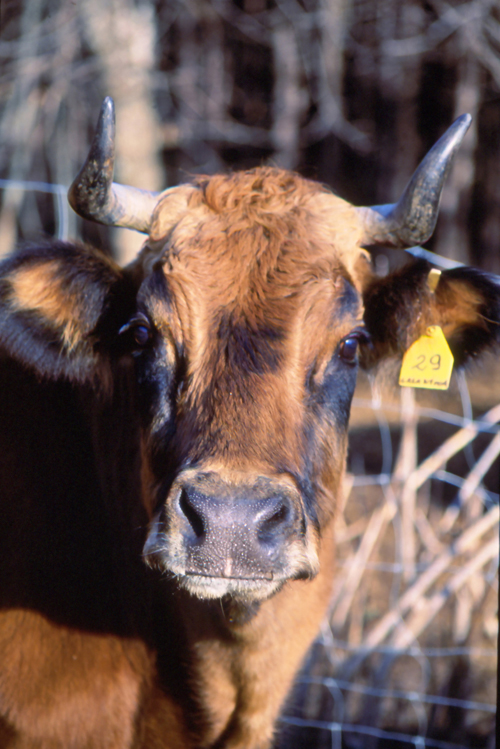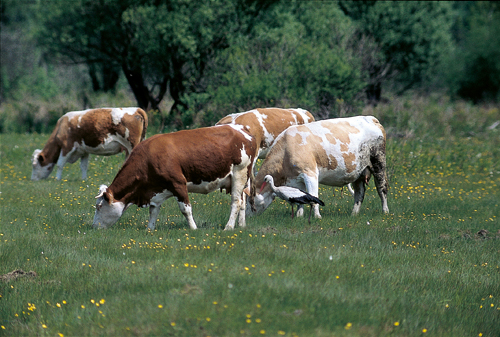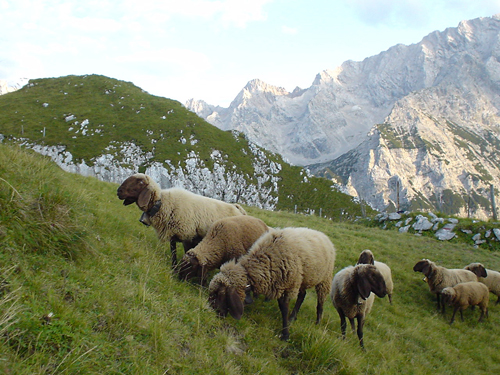Introduction
Managing the breeding of endangered traditional livestock breeds is the most important tool for safeguarding genetic variety, especially if the population is a small one. The ELBARN Ark and Rescue Centres (A&RCs) can provide a framework for this management where there is none already in place. By keeping nucleus herds and coordinating breeding with other farms and A&RCs, an essential part of the work for in-situ conservation will be achieved.
The following guidelines have been prepared to be used by owners of A&RCs. The guidelines have been set in motion by the contributors to “Work Group 3: Breeding” at the ELBARN Workshop in Kutna Hora, Czech Republic in February 2008. The experience in conservation breeding of the staff and management committee of the SAVE Foundation has also been used in order to complete the guidelines.
 |
|
photo: R. Fortina
Pontremolese - perhaps the rarest of all Italian cattle breeds. It was once used to work in the marble quarries of Tuscany.
|
Assessing the Situation:
Census and Monitoring
A preliminary condition for conservation work is good monitoring. Monitoring begins with an initial population census. These first results can be used to determine the status on the basis of objective criteria, for these purposes the endangerment criteria of the FAO or of the country the animals are found in can be used. This is then used (in combination with developmental trends) to determine the interval required between further census’. Regularly updating of the data is essential and, for severely endangered breeds, must be carried out every year.
Monitoring of Traditional Breeds
If there is no breeding programme running and no data is available, conservation activities have to start from scratch. This is why monitoring programs have been developed. Monitoring programs collate an overview of traditional breeds from old agricultural literature and also conduct search tours to find remnant populations. In monitoring programs one cannot and should not rely on commonly available statistics. Usually the figures are too high and, sometimes, remnants of a breed can be found that officially is considered long extinct.
The procedure of monitoring can be summarized schematically:
- Inventory of former diversity (regional or national):
- Evaluation of old agricultural literature
- Search for old veterinary dissertations and other special reports
- Interviews with specialists, old farmers, chroniclers etc (use photos and/or illustrations found in old literature)
- Specific search:
- in former locations (according to research)
- indications from interviews
- in places where other relicts have been found.
- Random search:
- with ethnic minorities within countries who may have different agricultural systems and traditions
- in remote, inaccessible regions
- in borderline locations (altitude, topography, exposed positions etc.).
The need for action can then be assessed based on the results of „scouting trips“ in the area. If there is little need for action, the monitoring has to be established or institutionalised for a longer time period. In the case of greater need for action a conservation program has to be set up. In case of urgent need a fast “rescue action” may be necessary.
Monitoring standard breeds (data recorded)
Basic information
Procedures should be put in place to make regular census of the population. The demographic structure should also be obtained: number of herds, distribution of herd size etc, also geographical locations. Such information is important for planning purposes to show the possibilities, and the associated problems, of efficiently organising a breeding programme. This should consider both the nucleus stock and those individuals outside of the nucleus.
Rate of inbreeding
Where pedigree recording is in operation the inbreeding coefficients of animals in the population and the apparent rate of increase in inbreeding should be calculated.
In the absence of pedigree recording the monitoring process should examine all the demographic information available. In these circumstances, the capacities of the farmers involved in the proposed programmes have to be taken into account and the construction of nucleus herds made accordingly. Any change in the human system (e.g. death of a farmer) might critically affect the effective population size. Therefore the monitoring process should be alert to this and, if appropriate, re-examine the design of the scheme with expert help, if required.
Fitness
The fitness of the population should be considered. In this context this means the ability of the breeding individuals to produce offspring that survive to maturity and are fertile. This incorporates such considerations as conception rates, litter sizes, offspring mortality. Whilst these traits may not be formally recorded the experience of farmers should give an indication of problem. Where problems are encountered they should be recorded and the cause should be investigated.
Selection
Where appropriate, selection strategy should be considered. If new selection procedures are to be introduced in the programme will these have an impact on the effective population size? Is the selection goal still appropriate for the population? Is there evidence that selection has led to outcomes that were not anticipated and which may be undesirable? These questions can be best addressed using properly recorded data and should, ideally, be discussed with a livestock geneticist.
If the population is not solely maintained in-situ but is (also) located outside the environment in which the breed was developed, some consideration should be given to the possibility of phenotypic adaptations being lost.
 |
|
photo: M. Schneider-Jacoby
Simmental - cattle grazing in nature reserves can help wildlife conservation.
|
Breed Management
Methods
The conservation of genetic reserves should proceed with the following priorities:
- Live conservation in-situ (with integration into mainstream agriculture and production)
- Live conservation ex-situ (nucleus herds, rescue stations, zoos, etc.)
- Cryoconservation
The last method is a useful supplementary measure but does not allow for continued development and adaptation of a breed.
Strategies
Once all available stock has been collected and recorded and a breed standard agreed upon, the animal group should be divided: those that fulfil ALL of the breed standard are “group A”, those that fulfil roughly 75% of the standard become “group B” and those that only fulfil about 50% of the standard become “group C”. Animals can then be “bred up” by crossing, for example, a “group A” animal with a “group C”. After three generations of crossing with a “group A” animal, females can be considered purebred. It is advisable to cross for four generations for a sire-line.
The optimal structure of an in-situ nucleus population is an equal proportion of unrelated breeding animals of both sexes. Ideally, an equal number of unrelated sires and dams should be present and, from each of them, a son or daughter, respectively, as reserve. Thus, the planned mating of „each with each“ approximates the ideal case of casual mating. This is usually not possible, however; as the keeping of sires is often difficult and the male lines are limited. As a result, it is important to:
- ensure sperm samples from every original sire
- include as many sons from each sire as possible in the breeding program; these sons should be by different dams
- use planned rotation mating and extension of the generation interval through artificial insemination
Conservation in-situ and ex-situ can, through spatial separation of the population, lead in time to the formation of new genetic lines.
The aim must be to achieve a minimal optimum; for a nucleus population of ruminants, for example, this should be 20:200 (20 males, 200 females).
In-situ live conservation should be given the highest priority because of its inclusion of traditional animal use in regional environmental and climatic conditions. This is why it is important that ELBARN A&RCs become breeding centres. This is necessary in order to integrate remnant populations outside the breeding area and those held by „hobby farmers“ into the general breeding population.
Decentralised in-situ conservation offers the greatest security against epidemics and other dangers. All available animals should be brought into the breeding programme from the outset and then divided into geographically separated groups. These groups should be kept on different A&RCs but the breeding management programme should be coordinated centrally, treating the animals as one population. With coordinated exchange of males between groups, genetic diversity can be maintained. This management should take place on a farmer/breed organisation level with advice and resources available from expert NGOs and relevant governmental organisations. It can be argued that an endogenous development of breed management systems, with expert support, has the most chance of long-term success.
Management
It is important to constantly question the breed standard and the breeding goal. This task often exceeds the capabilities of breeding associations and requires the help of experts or NGOs. Special working groups need to be established to deal with these questions about breeds.
No one can predict the future. In principle, every nucleus herd should be kept on a long-term basis. Long-term, in this case, means an unforeseeable time period until the day when conditions have changed and, for example, the nucleus herd is no longer significant for conserving the breed because of a large breeding population on farms. Even under these conditions, however, it is often useful to continue supporting the nucleus herd; it is often the only place to conserve a breed without breeding changes. A breed that is no longer endangered may well be released from conservation programs, if the requirements are fulfilled. This could take as many as 10 generations!
Stock Multiplication
To rapidly increase the herd population whilst maintaining the total existing gene-pool requires a great organisational effort. Artificial insemination and embryo transfer would be ideal supplementary techniques to the controlled mating every dam with every sire. Initially, simple reproduction is called for and selection for a phenotype is much less important. At the same time, carefully organised structures must be established to assure long-term survival.
Any surplus of offspring from nucleus herds should, whenever not needed for further conservation herds, be given to enthusiastic farmers on a contract basis. Only animals suitable for breeding should be passed on.
Basic Measures:
- increase the population size
- create security doubles
- decentralise the breed and distribute as many sires as possible
- extend the interval between generations
- use cryoconservation as additional security
Rescue
In the event of Rescue of animals, two basic principles are necessary:
- If the group to be rescued is too large for the emergency accommodation available, a wide-ranging selection of healthy animals should be made. This wide range should include all possible morphological and generational differences.
- As many animals as possible should be taken.
- As many unrelated males as possible should be included in the selection.
- Further details about the definition and process of Rescue can be found in the Rescue Guidelines.
Integration into Agricultural Production
The integration of traditional breeds into agricultural production systems, where possible, is desirable. Often breeds have unique characteristics that can be used to create niche products or provide a particular service.
This subject is developed further in the Marketing Guidelines.
 |
|
photo: B. Milerski
Swabian-Hall – German saddleback pig, bred in late 19th century
from a local landrace crossed with Berkshires and Essex breeds.
|
Conclusion
On-farm conservation requires the mobilisation of all stakeholders: farmers, organisations, government agencies and research institutes. These stakeholders need to create a coordinated breeding programme. This programme should begin with population census and recording of basic data and move on to create a procedure for long-term monitoring, develop breeding goals and also provide on the ground, practical action for successful conservation. Below is an overview of the principles of such a programme.
Overview
- The breeding programme should be managed by a group of interested and knowledgeable people, including all stakeholder levels.
- Breeds that are not already officially recognised by governments should be investigated and, where appropriate, should achieve official recognition.
- Cross-border programmes should be established where necessary.
- Census, registration and long-term monitoring are a prerequisite for success.
- Nucleus herds should be split into geographically distinct groups.
- As many male-lines should be established as is possible.
- Recording of basis data is essential (see Annex 1).
- Animals should be integrated into agricultural production.
Further Information
Literature resources:
“Community-Based Management of Animal Genetic Resources”, FAO Publication, 2001
“Draft Guidelines for Establishing Animal Breeding Strategies in Low- and Medium Production Systems”, Intergovernmental Technical Working Group on Animal Genetic Resources for Food and Agriculture, FAO Commission on Genetic Resources for Food and Agriculture, Rome, January 2009
“Secondary guidelines: Management of small populations at risk”, FAO Publication, 2000
“Utilisation and Conservation of Farm Animal Genetic Resources”, Oldenbroek, K., (ed.), Wageningen Academic Publishers, January 2007, ISBN: 978-9086860326
Useful Websites:
ELBARN: www.elbarn.net
SAVE Foundation: www.save-foundation.net
European Farm Animal Information System: http://efabis.tzv.fal.de/
 |
|
photo: J. Grasegger
Brown Mountain Sheep – a breed found in the Alps. The Brown Mountain Sheep lambs easily and has an arrhythmical season.
|
Annex 1: Minimum data required for each animal
- Species and breed
- Breed Name (local name or synonym)
- Sex
- Sire
- Dam
- Identification number, if available
- Date of Birth
- Origin (which farm?) and current location
- Date of slaughter/natural death
See http://www.save-foundation.net/docu/en/Pedigree_Analysis_Software.pdf for an overview of various breed management software available for recording data of small populations.
Annex 2: Work Plan for On-Farm Conservation Breeding
1st Phase:
Monitoring: census, methods of husbandry and usage, breed characteristics.
Result: assessment of needs.
2nd Phase:
Securing all of remnant population through purchase or support at present location.
Securing or creating at least 10 male lines.
Building up of nucleus herds and sperm banks.
Creation of an NGO herd book including minimum data
Scientific research (e.g. distance analysis).
Founding of management group for breed, if not already in existence.
3rd Phase:
Development of a long-term conservation plan for the breed, taking into account potential to integrate breed into agricultural production and/or other uses.
4th Phase:
Integration of the breed in agricultural production/usage.
Read more: ELBARN Marketing Strategies for Ark & Rescue Centres